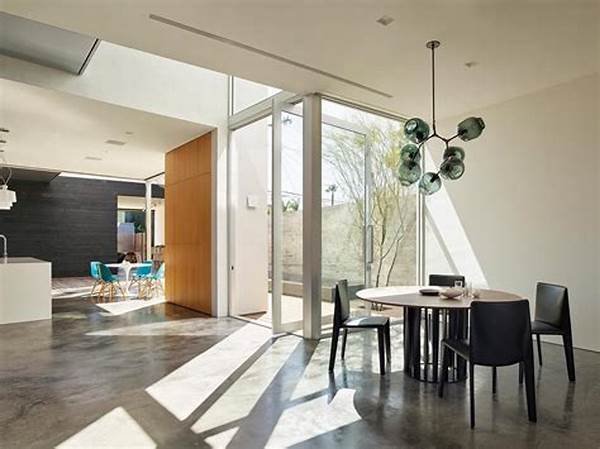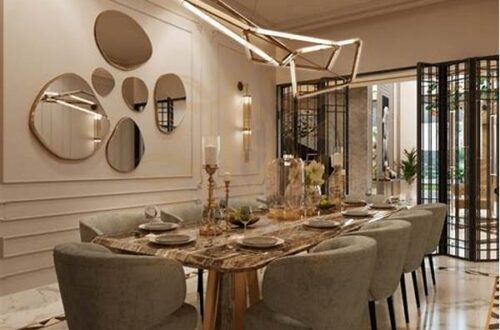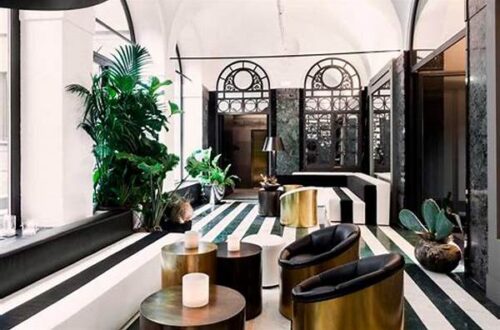In today’s world, where artificial lighting dominates our homes and workplaces, the importance of maximizing natural light in interiors cannot be overstated. Beyond just aesthetic appeal, natural light has a profound impact on our mood, productivity, and overall well-being. Imagine living in a space that not only looks brighter but also feels more inviting and alive. By making a few strategic changes, you can transform any interior into a light-filled sanctuary that uplifts and energizes you. Let’s delve into the transformative power of natural light and how it can be maximized within your living spaces.
Read Now : Sophisticated Seaside Color Schemes
The Benefits of Natural Light
Maximizing natural light in interiors goes far beyond mere aesthetics; it directly affects our health and outlook on life. Studies have shown that increased natural light exposure can lead to improved mood and reduced stress levels. Think about the invigorating feeling you get when sunlight streams through a window and fills the room—it’s more than just the warmth, it’s the sense of connection to the outside world. Not only does this improve mental health, but it also enhances productivity by creating a brighter, more inspiring work environment. Subsequently, by embracing natural light, we’re not only nurturing our bodies but also optimizing our living conditions, turning spaces into more holistic habitats.
Emphasizing maximizing natural light in interiors can also lead to substantial financial benefits. Relying less on artificial lighting reduces electricity consumption, translating into lower utility bills. This cost-effective solution is not only beneficial for your wallet but also eco-friendly, helping to decrease your carbon footprint. When the sun naturally lights your home, you are contributing to a more sustainable future and embodying a lifestyle that respects and utilizes renewable resources. Therefore, investing in methods to increase natural light will pay dividends in more ways than one.
Incorporating natural light into your home design also revamps the aesthetic appeal, making spaces feel larger, more open, and inviting. There’s a unique quality to natural light that cannot be replicated by artificial lighting—its variability offers depth and dynamism to a room, changing with the seasons and weather conditions. Every aspect of your interior can benefit—from enhancing the colors and details of your decor to emphasizing architectural features. Ultimately, maximizing natural light in interiors amplifies the inherent beauty and functionality of your home or workspace.
Strategic Window Placement
1. Positioning windows on north-facing walls can help maximize natural light in interiors by capturing the consistent and soft illumination from the northern hemisphere’s path of the sun. This placement minimizes harsh shadows and enhances ambient lighting.
2. Floor-to-ceiling windows are an ideal solution for maximizing natural light in interiors, offering an unobstructed flow of daylight throughout the space. This design choice connects the indoors with the outdoors, creating a seamless and expansive feel.
3. Skylights offer a unique vantage for maximizing natural light in interiors, channeling sunlight from above directly into the room. This innovation can transform spaces that might otherwise lack direct window access, filling them with warm, overhead light.
4. Transom and clerestory windows are excellent for maximizing natural light in interiors. Positioned high on walls, they allow sunlight to penetrate deeper into rooms, creating an airy and expansive appearance while ensuring privacy.
5. Windows strategically placed at opposite ends of a room encourage cross-lighting, which maximizes natural light in interiors. This technique ensures an even distribution of light, making any space feel balanced and harmonious.
Interior Layout Adjustments
Understanding the role of interior layout is crucial when aiming to maximize natural light in interiors. By strategically arranging furniture and removing obstructions, you can channel light more efficiently throughout your space. Think about relocating bulky furniture away from windows or using open shelving to avoid blocking sunlight. Light can be obstructed by poor layouts, but small adjustments can make a huge difference. Rooms can instantly feel more spacious and inviting. When you prioritize natural light flow in your design, you enhance both the functionality and aesthetic appeal of your home. This unifying approach allows light to be the guiding star in home planning.
Furniture choices also play a vital role in maximizing natural light in interiors. Selecting pieces with reflective surfaces, such as glass or shiny metals, can help bounce light around the room. Avoid dark, heavy materials, and instead opt for lightweight, light-colored fabrics that complement the brightness and airiness of a naturally lit room. Mirrors are another powerful tool in your arsenal; strategically placed, they can double the effect of natural light, brightening even the most shadowed corners. Such choices don’t just enhance brightness; they also give rooms a fresh, lively feel, turning ordinary spaces into extraordinary ones.
Utilizing Reflective Surfaces
Reflective surfaces are your secret weapon in maximizing natural light in interiors. By incorporating mirrors, metallic finishes, and glossy materials, you can enhance the natural luminosity and distribute it throughout the space. Mirrors, especially, should be strategically positioned opposite windows to reflect the light deeper into the room. Metallic fixtures like light-finished gold or silver can be both functional and decorative, amplifying light and adding a touch of elegance. Even the choice of paint can transform a room’s brightness—light, glossy finishes will bounce incoming light around the room, increasing its reach. Harnessing reflective surfaces is an effortless yet powerful method to intensify light flow in any area.
1. Mirrors multiply the effect of natural light, making rooms appear larger and more spacious.
2. Glass tabletops and light fixtures facilitate the free movement of light around the space.
3. Glossy tiles in kitchens or bathrooms enhance light dispersion brilliantly.
Read Now : Organic Material Interior Furnishings
4. Metallic fixtures act as light amplifiers, brightening areas while adding a chic element.
5. Polished wood finishes can subtly increase room luminance without major redesigns.
6. Light-colored ceilings reflect natural light downwards, maximizing room brightness.
7. Acrylic furniture pieces maintain openness while delivering a modern aesthetic.
8. Stainless steel appliances in kitchens can significantly enhance the impact of natural light.
9. Shiny curtains can diffuse light effectively, providing both privacy and enhanced illumination.
10. Incorporating reflective home décor items can create a vibrant and lively atmosphere.
Color Choices and Their Impact
Color plays an instrumental role in maximizing natural light in interiors. Light colors, particularly whites and pastels, are excellent at reflecting light rather than absorbing it, thus enhancing the brightness of a room. Painting walls, ceilings, and even floors in lighter hues can give your space a more radiant aesthetic. On the other hand, darker colors tend to absorb light, making spaces feel smaller and more enclosed. By selectively using lighter colors, not only do you reflect more light, creating a sense of openness, but you also augment the overall atmosphere in your home. The impact is immediate—a lighter, airier, and more welcoming environment that you’ll love to spend time in.
Additionally, strategic use of accent colors and art can complement the primary color palette, drawing the eye and amplifying natural light. Incorporating colorful cushions, artwork, and accent pieces can add vibrancy without overwhelming the senses. These slight touches can contrast well against light backgrounds, creating visual interest and depth. As a result, a well-thought-out color scheme not only maximizes natural light in interiors but also personalizes your living spaces, ensuring they reflect who you are. A harmonious balance of color and light ultimately transforms the ambiance, making any interior feel more dynamic and inviting.
The Role of Technology
In a world driven by innovation, technology can be a pivotal ally in maximizing natural light in interiors. Smart home systems equipped with sensors can automate and adjust window coverings, ensuring that natural light is leveraged optimally throughout the day. With the tap of a finger, you can control blinds to either diffuse or harness light based on the sun’s position. This adaptive use of technology enhances the comfort and efficiency of your spaces. Furthermore, energy-efficient windows and advanced glazing techniques are continuously evolving, offering solutions that let in abundant light while managing heat and UV exposure. By embracing such advancements, you not only brighten your home but also make a smart, future-forward investment.
By understanding and applying these concepts, you can transform any interior, no matter how small or dimly lit, into a vision of light-filled luxury. Maximizing natural light not only enhances aesthetic value but also nurtures well-being, blending the beauty of design with the practicality of light—a truly illuminating experience.





